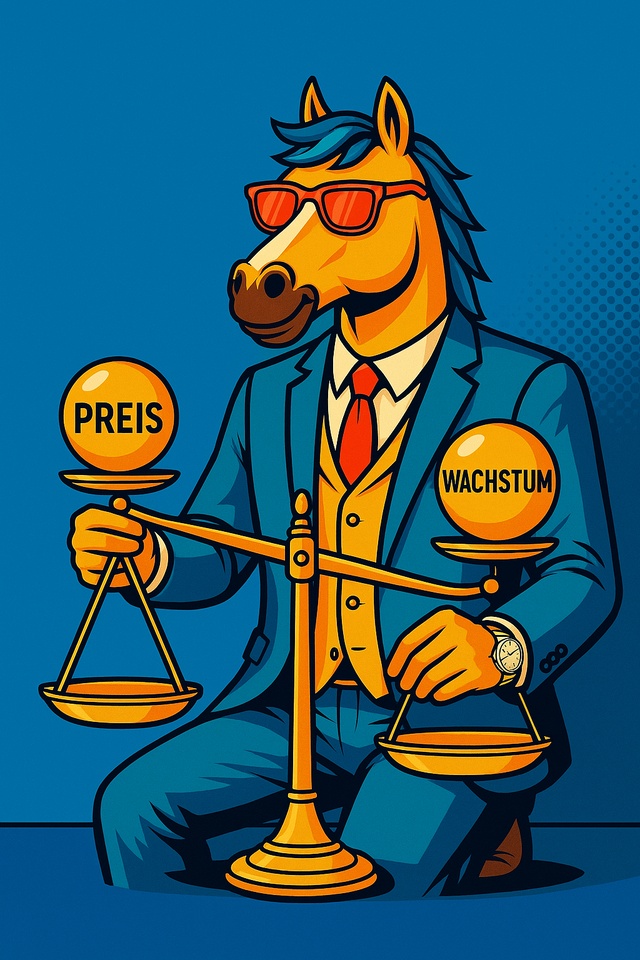Reading time: approx. 8 minutes

A comment from @Tenbagger2024 gave me the idea to write this article - about a key figure that many investors pay little attention to in everyday life, but which is essential if you really want to understand growth and valuation: the PEG ratio.
The last article on the Rule of 40 was about how to measure operational quality - in other words, whether a company is not only growing but also remaining profitable. Today, we are looking at the second part of the equation: the price of growth. Because quality is only interesting if it is available at a reasonable price. This is precisely what the PEG ratio aims to illustrate.
The formula is simple:
PEG = P/E ratio / earnings growth (% per year)
A PEG of 1 is considered a fair valuation. Values below 1 may indicate undervaluation, values above 1 may indicate ambitious or already priced-in expectations. However, the figure alone says little - the decisive factor is how stable and realistic the growth actually is.
The classic P/E ratio only looks at the moment. It says what the market is paying today for one euro of profit, but not what it expects tomorrow. The PEG ratio adds the time dimension to this snapshot. It combines price and dynamics - and makes it clear whether a company is priced too high or surprisingly low for its future.
For example, a software company with a P/E ratio of 40 appears expensive at first glance. However, if profits grow by 40% annually, the PEG is 1 - and the valuation is suddenly logical. Conversely, a telecoms group with a P/E ratio of 7 may be overvalued if profits are barely growing. PEG helps to avoid these deceptions by putting growth in relation to price.
Practical examples (as of November 1, 2025):
$MSFT (+1,55 %) (Microsoft)
P/E ratio around 37, expected earnings growth of around 15% → PEG ≈ 2.5.
Microsoft remains a prime example of stability and pricing power. A PEG above 2 signals: The market pays for reliability here. High margins, enormous cash flows, but also a premium valuation.
$GOOG (+1,41 %) (Alphabet)
P/E ratio around 28, growth approx. 15 % → PEG ≈ 1.9.
Formally overvalued, but contextually fair. Alphabet is growing steadily, earning above average and investing aggressively in AI. A PEG close to 2 shows: quality is not cheap - but predictable.
$NVDA (+2,49 %) (NVIDIA Corporation)
P/E ratio around 35, expected earnings growth around 33% → PEG ≈ 1.05.
The supposedly expensive AI champion shows that high multiples do not necessarily mean exaggeration. Earnings growth almost completely offsets the valuation. NVIDIA is emblematic of "expensive but deserved". The risks lie less in the PEG than in the cyclicality of demand.
$PLTR (+2,9 %) (Palantir Technologies)
Forward P/E around 200, growth around 35% → PEG ≈ 6.
An extreme case. Strong growth, but a valuation that has long since become more future than present. The PEG shows how quickly a growth story can turn into an overvaluation.
$T (+0,6 %) (AT&T)
P/E ratio 7, growth 1-2 % → PEG between 3.5 and 7.
The classic fallacy. AT&T looks cheap because the P/E ratio is low, but remains an example of a lack of momentum. A high PEG despite a low valuation shows that price alone is not an opportunity if there is no growth.
$IREN (+21,69 %) (Iris Energy)
Forward P/E ratio approx. 18, expected earnings growth of over 60% → PEG ≈ 0.3.
An opposite pole. Favorable on paper, as the valuation is low in relation to the expected growth. But be careful: this only applies if the growth is realized. If the Bitcoin price falls or mining profitability drops, the ratio will immediately tip. A low PEG is not a free ride, but a bet on realization.
These examples show: PEG is not a mathematical judgment, but a tool for classification. It does not explain what a share costs, but why. Microsoft and Alphabet are expensive, but their valuation is understandable. Palantir is growth on credit. AT&T is "value" without movement. NVIDIA is proof that high growth can justify a high valuation. Iris Energy, on the other hand, stands for speculative momentum - lots of potential, but little predictability.
PEG does not separate cheap from expensive, but deserved from undeserved.
It is often said that PEG only makes sense within individual sectors. This is only partially true. It was originally developed by Peter Lynch to make growth comparable across sectors - i.e. tech versus industry, pharmaceuticals versus consumer goods.
The PEG allows precisely this comparison because it puts valuation and growth in relation to each other. Nevertheless, interpretation is still necessary:
20% growth in software is fundamentally different from 20% in consumer goods. Capital intensity, margins and scalability influence how sustainable growth really is. The same PEGs are therefore mathematically comparable, but not economically equivalent.
Used correctly, the PEG ratio perfectly complements the Rule of 40. While the Rule of 40 shows how well a company is performing, the PEG shows what the market demands in return. Together they provide a complete picture - quality meets valuation.
PEG is not an instrument for quick judgments, but a means of discipline. It helps to ground euphoric phases and recognize valuation bubbles at an early stage. It is therefore less a key figure than a compass - a guide between price, growth and reality.
What do you think?
- Which of your growth stocks remain justifiable even with a PEG > 1 - and why?
- Are there any stocks that look cheap but have been stagnating for years?
- How much attention do you pay to the price/growth ratio in your investments - more than just the P/E ratio?
- And where do you personally draw the line between "paying for quality" and "paying for hope"?











